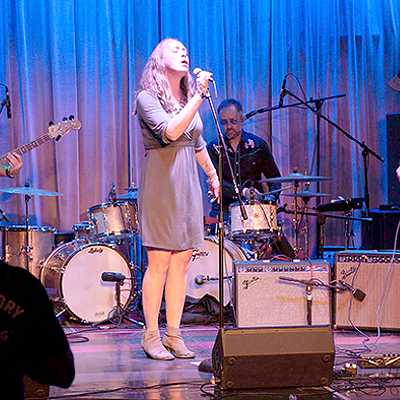"My telephone battery is going down," he says apologetically. "I'll tell you what. I'll put it on the hook and let it heat up, and I'll phone you back."
Routinely described as one of the towering figures of 20th-century modern dance, the 84-year-old choreographer brings his Merce Cunningham Dance Company to Centennial Hall this Saturday for one performance.
Despite the bedeviling cell phone, Cunningham is no stranger to technology. He was associated for 50 years with the late avant-garde composer John Cage, who put everything from buzzers to gongs into his electronic sound compositions, and he was one of the first choreographers to compose dances on computer. And he accepts the cell phone's random operations with equanimity.
"I'm sorry about this morning," he says when he calls back. "That's the trouble with working with electronics. It does things all of a sudden that we think it shouldn't do."
He could as easily be talking about his dances. Starting in the 1940s and '50s, Cunningham began creating dances whose disconnected and seemingly random movements startled audiences used to, say, Martha Graham's mythological narratives and José Limón's solemn stories. Cunningham wanted to strip dance of story lines and symbolism and turn it into an art of pure form--not unlike the abstract expressionist painters, his friends and contemporaries, who were trying to do the same with pigment and canvas.
These mid-century artists believed that if they stripped dance or painting of surface meaning, they could achieve "a deeper level of reality--beyond subjectivity," as the dance writers Nancy Reynolds and Malcolm McCormick put in it in their new book, No Fixed Points. Cunningham readily acknowledges that he was not alone in his efforts.
"Things were beginning to change, small things in the art world, in the visual art world--(artists) began to see things in a different way," Cunningham explains on the now-cooperative cell phone. He often worked with cutting-edge artists who were breaking down boundaries in their own art forms. A frequent collaborator, Jasper Johns, coincidentally opens a show of his prints at the University of Arizona Museum of Art this weekend.
"I worked with Jasper a great deal, actually, over the years," Cunningham says. "He made sets and costumes."
Painters could easily get rid of surface meaning by concentrating on brushstrokes and pigment; dance, with its accepted sequences of movements, was a little trickier. But inspired by the I Ching, the Chinese Book of Changes, the choreographer hit upon a scheme: He would break up the movements in a projected dance, and re-order them according to the principles of chance expounded in the book. Cunningham decided which gestures the dancers would dance, but he wouldn't assemble the phrases in the expected way.
"I would make up a series of movements quite isolated from each other," he explains. "And then using pennies or dice or whatever, I made the decision as to what movement followed what."
Adding to the element of chance was the independence of the music and movement. The usual procedure was for Cage and Cunningham to compose independently, and then splice their disparate creations together on the stage. Cage wrote the score for the first piece in the Tucson concert, "Suite for Five in Space and Time," in 1956. The painter Robert Rauschenberg designed the original costumes.
"It was "one of the first pieces in which I used chance operations," Cunningham says. Recently reconstructed for a 50th-anniversary concert at Lincoln Center, the work "consists of a number of solos and a duet, and a trio and a quintet; it's a very formal arrangement. ... The continuity is not how you or I think the continuity should go, but brings up (something) totally different."
Such works sometimes confounded his dancers, he says.
"In the beginning, it was extremely difficult, because we had habits of moving. These were all being broken," Cunningham notes. "There were always two questions from dancers (about chance composition). 'What if you can't do it, or what if you don't like it?' The second one, I skipped that and decided, well, I'll try anything. ... Often there were things that were physically impossible, but my eye saw something I hadn't seen before."
The second piece on the program, "Pictures," is from 1984.
"That again is using a chance scheme. I made 64 small drawings of figures, like stick figures. ... So you had 64 different possibilities of these phrases." Cunningham shuffled the drawings to determine the sequence of movements.
"It was absolutely fascinating for me to make. The visual thing was so constant with the shapes, but they always kept being different from what I expected," he adds with his habitual chuckle.
The final work, 2002's "Fluid Canvas," is a big piece for 14 dancers; the set incorporates computer-generated moving images on the backdrop. The "lively score" by John King uses both electronic sound and noises made by the composer's two young children, Nora and Elmo.
"They're quite smart, the two of them," Cunningham says with delight.
If the Tucson show roughly outlines Cunningham's career, from the 1950s to the 2000s, Cunningham's life traces a kind of history of 20th-century dance and the avant-garde. As a young man, he studied at the Cornish School for the Fine Arts in Seattle and at the influential Mills College summer dance school in Oakland. An extravagantly gifted dancer, known for his sense of humor, Cunningham was quickly tapped by Martha Graham.
"The first four or five years in New York, I was with the Graham company as a soloist," he remembers. "She was an extraordinary woman in the theater. I enjoyed performing with her; being on the stage with her was something so good."
Cunningham also studied ballet at George Balanchine's School of American Ballet, and set a piece on the New York City Ballet when it was just 1 year old. An influence on a whole generation of young artists, Cunningham's work so deeply influenced Twyla Tharp that she choreographed a tribute piece called "After 'Suite,'" in honor of the "Suite for Five." Nowadays, Cunningham is an éminence grise, with work in the repertories of ballet and modern dance companies the world over, but he still seeks out young contemporary artists.
Just last fall, the octogenarian premiered a new work, "Split Sides," at the Brooklyn Academy of Music, in collaboration with the alternative rock bands Radiohead and Sigur Ros, of Iceland.
"It was wonderful!" he exclaims. "I like them so much. ... There are so many interesting things now. I'm trying to keep up."
Cunningham has long since stopped dancing--he laughs when asked if he still performs--but he regularly tours with his troupe. Nor has he stopped composing. He explains with another chuckle, "I keep going on as much as I can."














